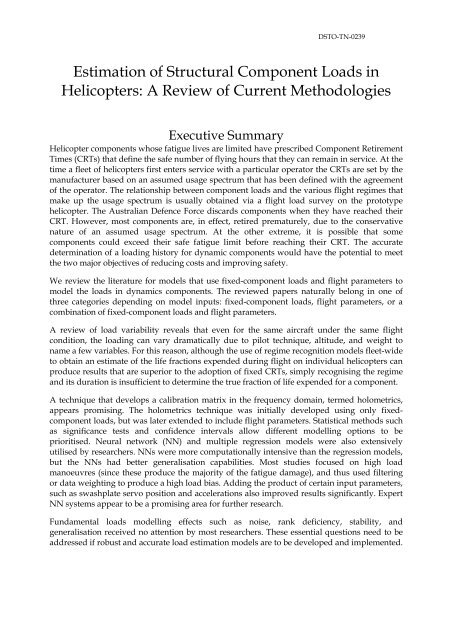Estimation of Structural Component Loads in Helicopters: A Review ...
Estimation of Structural Component Loads in Helicopters: A Review ...
Estimation of Structural Component Loads in Helicopters: A Review ...
Create successful ePaper yourself
Turn your PDF publications into a flip-book with our unique Google optimized e-Paper software.
DSTO-TN-0239<strong>Estimation</strong> <strong>of</strong> <strong>Structural</strong> <strong>Component</strong> <strong>Loads</strong> <strong>in</strong><strong>Helicopters</strong>: A <strong>Review</strong> <strong>of</strong> Current MethodologiesExecutive SummaryHelicopter components whose fatigue lives are limited have prescribed <strong>Component</strong> RetirementTimes (CRTs) that def<strong>in</strong>e the safe number <strong>of</strong> fly<strong>in</strong>g hours that they can rema<strong>in</strong> <strong>in</strong> service. At thetime a fleet <strong>of</strong> helicopters first enters service with a particular operator the CRTs are set by themanufacturer based on an assumed usage spectrum that has been def<strong>in</strong>ed with the agreement<strong>of</strong> the operator. The relationship between component loads and the various flight regimes thatmake up the usage spectrum is usually obta<strong>in</strong>ed via a flight load survey on the prototypehelicopter. The Australian Defence Force discards components when they have reached theirCRT. However, most components are, <strong>in</strong> effect, retired prematurely, due to the conservativenature <strong>of</strong> an assumed usage spectrum. At the other extreme, it is possible that somecomponents could exceed their safe fatigue limit before reach<strong>in</strong>g their CRT. The accuratedeterm<strong>in</strong>ation <strong>of</strong> a load<strong>in</strong>g history for dynamic components would have the potential to meetthe two major objectives <strong>of</strong> reduc<strong>in</strong>g costs and improv<strong>in</strong>g safety.We review the literature for models that use fixed-component loads and flight parameters tomodel the loads <strong>in</strong> dynamics components. The reviewed papers naturally belong <strong>in</strong> one <strong>of</strong>three categories depend<strong>in</strong>g on model <strong>in</strong>puts: fixed-component loads, flight parameters, or acomb<strong>in</strong>ation <strong>of</strong> fixed-component loads and flight parameters.A review <strong>of</strong> load variability reveals that even for the same aircraft under the same flightcondition, the load<strong>in</strong>g can vary dramatically due to pilot technique, altitude, and weight toname a few variables. For this reason, although the use <strong>of</strong> regime recognition models fleet-wideto obta<strong>in</strong> an estimate <strong>of</strong> the life fractions expended dur<strong>in</strong>g flight on <strong>in</strong>dividual helicopters canproduce results that are superior to the adoption <strong>of</strong> fixed CRTs, simply recognis<strong>in</strong>g the regimeand its duration is <strong>in</strong>sufficient to determ<strong>in</strong>e the true fraction <strong>of</strong> life expended for a component.A technique that develops a calibration matrix <strong>in</strong> the frequency doma<strong>in</strong>, termed holometrics,appears promis<strong>in</strong>g. The holometrics technique was <strong>in</strong>itially developed us<strong>in</strong>g only fixedcomponentloads, but was later extended to <strong>in</strong>clude flight parameters. Statistical methods suchas significance tests and confidence <strong>in</strong>tervals allow different modell<strong>in</strong>g options to beprioritised. Neural network (NN) and multiple regression models were also extensivelyutilised by researchers. NNs were more computationally <strong>in</strong>tensive than the regression models,but the NNs had better generalisation capabilities. Most studies focused on high loadmanoeuvres (s<strong>in</strong>ce these produce the majority <strong>of</strong> the fatigue damage), and thus used filter<strong>in</strong>gor data weight<strong>in</strong>g to produce a high load bias. Add<strong>in</strong>g the product <strong>of</strong> certa<strong>in</strong> <strong>in</strong>put parameters,such as swashplate servo position and accelerations also improved results significantly. ExpertNN systems appear to be a promis<strong>in</strong>g area for further research.Fundamental loads modell<strong>in</strong>g effects such as noise, rank deficiency, stability, andgeneralisation received no attention by most researchers. These essential questions need to beaddressed if robust and accurate load estimation models are to be developed and implemented.
















